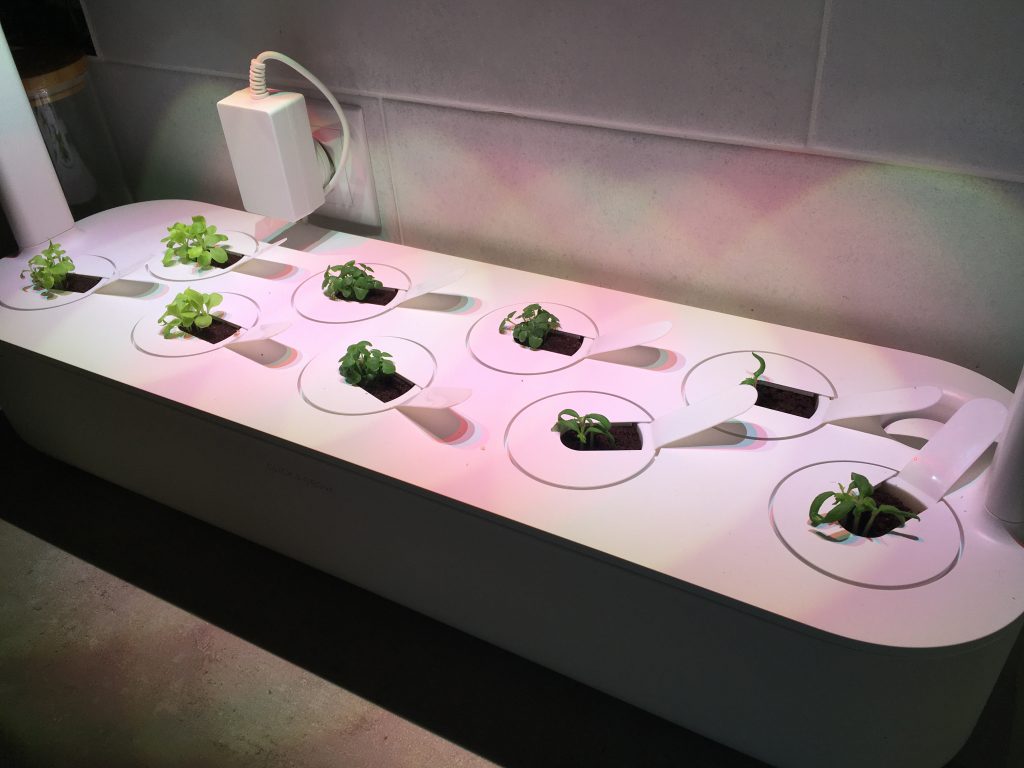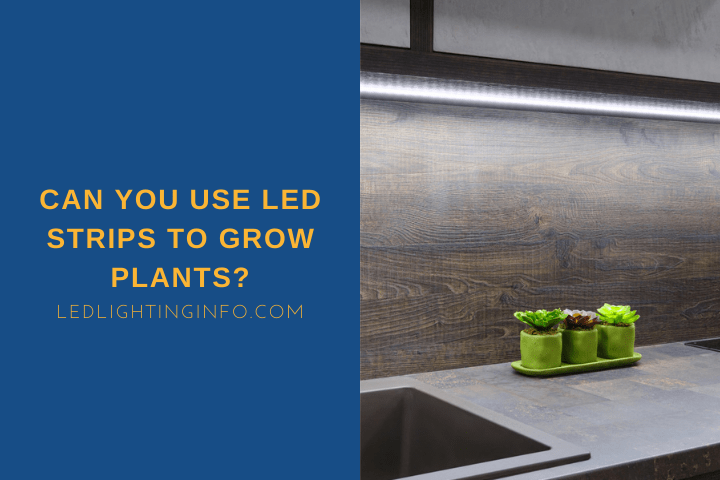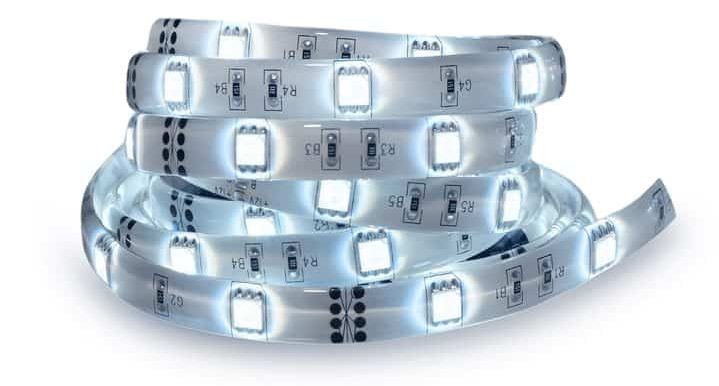Outdoor plants have access to an abundance of sunlight, essential for their healthy growth. If you’re growing plants indoors, you need to recreate this sunlight, and plants can’t always get everything they need through the filter of a glass window.
How can you help plants to grow indoors without access to sunlight? Can strip lights do a good enough job?
LED strip lights can assist in the successful growth of indoor plants and are good for controlling the color of lights for your plant, but alone they won’t usually be bright enough to encourage most seedlings to develop. In most cases, LED strips should be used alongside other brighter and larger bulbs.
To learn more about LED strip lights for plant growth, I’ll address the following things to consider:
- Are LED strips powerful enough for plant photosynthesis?
- The color spectrum capacity of LED strips
- Whether or not strip lights are a practical solution for plant growth
Table of Contents
Do LED Strip Lights Emit Enough Light For Photosynthesis?
Many LED strip lights aren’t bright enough for photosynthesis, which needs around 2,000 lumens per square foot. However, brighter strips with 5050 chips can reach the 2,000 lumens level needed to grow plants.
In nature, plants rely on sunlight to grow and photosynthesize. When they’re grown indoors, plants need to be kept in something close to their natural environment.
To thrive and grow at a good pace, most plants need artificial replication of natural sunlight. The light they receive should be bright, and this is particularly important for seedlings and younger plants.
To see a plant through the whole of its growing cycle, it’s a good idea to have lighting at a level of around 2,000 lumens per square foot at least.
Most standard LED strips only emit around 450 lumens per foot. Unless you are purchasing brighter LED strips, you might want to use your LED strips to supplement other lighting forms.
For upwards of 2,000 lumens, you will need brighter strips of 5050 or above.
The 5050 LED strips have 5.0mm x 5.0mm dimensions with three LED chips in one, so they’re much brighter than standard LED strips and are better suited to plant growth.
Many mature plants can cope with a little less light, as they don’t need that strong initial sunlight that would trigger a seedling to start growing. Most plants, if already mature, can comfortably survive with dimmer lighting.
There are some benefits to using LED lights for plants. LED lights don’t emit a lot of heat, so they won’t cause plants to dry out or suffer from burns.
Can LED Strips Emit Required Color Spectrum?

Plants rely on the full-color spectrum to thrive when they’re growing indoors. They need blue light to grow, with red light stimulating flower production. LED strips can emit the required red and blue light wavelengths.
Still, you must make sure that the strip lights you purchase emit the specific wavelengths you need – any white strips should advertise this on the packaging or in the specification if you’re buying online.
If you do not provide both blue and red light wavelengths, you can expect your indoor plants not to flower (and some types might not grow at all).
This is why you can’t just determine how suitable LED lights are for plants based on their luminosity. Lumens are weighted more towards the yellow light that humans perceive, but plants don’t need yellow light.
Intense blue light is vital during the early stages of growth to encourage a seedling to develop.
For optimal growth, plants should receive light around 6500K as it is closest to daylight. For budding, flowering, and fruit production, lights around 3000K are required.
Most plant growth lights are full-color spectrum lights, with the red and blue lights required to see a plant through every stage of growth.
Single color strips will typically emit white light with a range of 2200K to 6500K, ideal for all plant growth stages.
You could also choose a dynamic tunable LED strip light, setting it for both high and low wavelengths simultaneously.
Other options include purchasing multiple separate strip lights, some red and some blue, or choosing an RGB strip light and alternating between blue and red settings.
The first of these options will be much more convenient than the latter.
Can I Use LED Strip Lights As Grow Lights?

LED lights are increasing in popularity as growing lights. They are energy efficient, can cover a full-color spectrum, and don’t emit excessive heat that can burn or dehydrate plants. You can also buy specialist grow lights as strips.
The successful growth of a plant depends not so much on the brightness of light, but on the wavelengths of color it receives. It is possible to grow plants with strip lights, but you must be careful to buy the right lights to maximize your chance of success.
Single-color strips are a good choice because they contain the entire spectrum.
Otherwise, you will need lights to cover both red and blue wavelengths.
But the best are dedicated LED grow lights, which are strips designed to help plants thrive indoors.
These use different LED light chips to provide the right wavelengths of light, and they can be set to automatically switch on and off to better simulate natural light.
If you use a single RGB strip, make sure you buy 5050 strip lights, which are brighter than the standard LED strips and set them to purple, containing the right mix of blue and red.
This will encourage early seedling development and flowering. You can set an RGB light to white, but it’s not completely white, so it makes sense to instead focus on the more critical blue and red.
Of course, some plants will not survive and thrive with LED lighting alone. LED strips do not give off much heat, and some plants rely on heat and light for their successful growth.
You shouldn’t expect to create a thriving tomato plant under LED strips. However, most plants that don’t require a lot of heat should successfully grow under 5050 full-spectrum LED strips if they’re close.
How Far Should LED Grow Lights Be Placed From Plants?
The distance between your LED lights and your indoor plants varies depending on the strength of the lights, but as a rough guide, place the LED lights around 12 inches from seedlings and move the lights further from plants once they start to flower – anything from 18 to 36 inches should suffice.
It’s important to manage the intensity of the lights. Even with LED lights that don’t emit much heat, you don’t want anything too intensive on the leaves. An LED grow light can be very bright, and too much brightness can actually be worse for your plants.
If you can’t move the plants, make sure that any lights to grow plants that you’re using are easy enough to adjust so you can increase the distance as the plants mature. They’ll still offer sufficient light output to help your plants thrive without over-exposing them.
Best LED Strip Lights For Plants
If you want to use LED strip lights for your plants, here are three of the best options.
Kullsinss Plant Grow Light Strips
These dedicated LED grow lights are specifically designed for plant growth. They are full spectrum LED grow lights, offering all the color wavelengths your plants need, and they have a handy timer to mimic sunlight.
No products found.
Fregenbo LED Growth Light
These LED strips are another option if you want specific LED growth lights and are better for more serious indoor gardeners who have lots of indoor plants to attend to. What I like about these is that they come with extra extensions, so you can arrange them as you wish.
No products found.
Final Words
LED strip lights can be used as your sole growing lights or part of a more complex setup alongside other lights.
Natural sunlight will always be better than artificial light, but with the right choice of strips, the best LED lights are suitable.
Their flexibility can be highly beneficial, allowing you more accurate control of your growth lighting position. With a full-color spectrum, you can be confident that plants will get everything they need.
To maximize your chances of success, you will want to purchase brighter 5050 strip lights. These will cost more but have a higher output in lumens for successful seedling germination.
Check out my definitive guide to strip LED lights if you want to know more about them before you buy.


